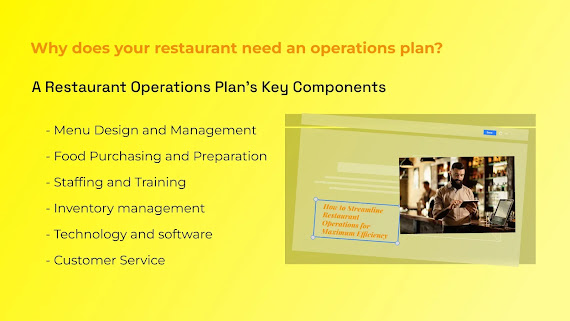Quick Service Restaurants - How to Start a Quick-Service Restaurant
What Is a Quick-Service Restaurant (QSR)?
A Quick-Service Restaurant, often abbreviated as QSR, is a type of fast-food establishment that specializes in serving quickly prepared meals with minimal table service. These restaurants cater to people on the go, making them perfect for individuals in a rush, students looking for a quick bite between classes, or anyone with limited time for lunch. Quick-service restaurants come in various sizes, ranging from small kiosks to major chain establishments. However, their hallmark is always speed and convenience.
In today's fast-paced world, quick-service restaurants have become increasingly prevalent. Customers seek affordable, fast food options that can be conveniently grabbed on the go. These eateries typically feature a simple Point of Sale (POS) system, a limited menu, and orders are placed at the counter or through a drive-thru. Fast-food chains are ubiquitous in cities and towns worldwide, catering to the busy lifestyles of many consumers.
Types of Quick-Service Restaurants
Quick-Service Restaurants typically operate as chains or franchises, deriving profits from the volume of customers they serve. Running multiple outlets allows these businesses to capitalize on foot traffic from various locations, thus increasing the company's overall value. Examples include Starbucks, which offers complimentary food items alongside its beverages, and pizza chains like Pizza Hut and Domino's, known for fast food and light beverages. Maintaining a high level of standardization is crucial for QSRs to deliver prompt service to customers, and they fall into three categories:
Self-Service Restaurants: Customers approach the ordering counter to place and collect their orders. They retrieve their orders from the counter once they're prepared and announced.
Assisted Self-Service Restaurants: In these establishments, either the customer's order is delivered to their table, or a staff member serves the food directly to the customer's table.
Full-Service Restaurants: These restaurants have table staff who take orders and serve food directly to diners.
How QSRs Differ from Fast-Casual Restaurants
Quick-Service Restaurants and fast-food eateries are often compared to fast-casual restaurants, and while they share some similarities, there are key differences between these restaurant formats:
Quality and Speed: Both QSRs and fast-casual restaurants prioritize fast service, but fast-casual establishments typically prepare food to order. QSRs, on the other hand, pre-cook their menu items to ensure almost immediate food delivery. While this makes QSR service faster, food quality might be slightly lower.
Takeout or Dine-In: QSRs and fast-casual restaurants usually offer both dine-in and takeaway options. However, fast-casual restaurant patrons are more inclined to dine in, often enjoying a more relaxed dining experience. As a result, fast-casual restaurants often invest in interior design to create a specific ambiance.
Drive-Through: Drive-through service is rare in fast-casual restaurants but common in QSRs. Drive-throughs help QSRs free up indoor tables and reduce waiting times.
Fast-casual restaurants prepare food fresh to order, resulting in slightly slower service compared to QSRs, where the food is ready almost instantly. This is why drive-through models are common in QSRs but not in fast-casual establishments.
Benefits of Opening a Quick-Service Restaurant
Owning and operating a QSR has several advantages:
Large Market Segment: The fast-food and QSR market is substantial and continuously growing. In the United States, the QSR market size was estimated at USD 293.8 billion in 2023, projected to reach around USD 454.3 billion by 2030. This market offers substantial growth potential.
High Customer Retention: QSRs benefit from high customer turnover rates, as many customers opt for takeout or use the drive-through. Quick service ensures that tables free up quickly, allowing for the efficient service of a large number of customers during each service period, leading to increased revenue.
Franchising Opportunities: Many fast-food restaurants operate through franchising, allowing individuals to open QSRs under established brand names. Franchisees handle day-to-day operations while benefiting from existing branding and popular menu items, simplifying the process of building a customer base and reducing marketing costs.
Low Operating Costs: QSRs typically have lower operational costs than full-service restaurants. Since many patrons opt for takeout, these restaurants can operate in smaller retail spaces with smaller staff sizes. Additionally, standardized menus with consistent ingredients can lead to cost savings, especially when ordering supplies in bulk.
How to Start a Quick-Service Restaurant
While the top 20 QSRs are usually large fast-food chains, most QSRs are not, and there's no need for a drive-thru, fried chicken, or ice cream machine malfunctions to run a successful QSR in 2023. Here are the steps to consider if you want to start your own quick-service restaurant:
Create a Business Plan: Start by developing a comprehensive business plan that outlines your restaurant's unique model, including the type of QSR you plan to operate, your menu, operations, technology, and what sets you apart from competitors.
Secure Financing: Restaurant start-up costs can be substantial, so consider various financing options available for your QSR venture.
Obtain Licenses and Permits: Ensure you have all the necessary licenses and permits to operate your QSR legally. Consult local and state regulations for specific requirements.
Locate and Purchase Equipment: Find an appropriate location, potentially with the assistance of a commercial real estate professional, and equip it for service.
Create Your Menu: Develop your menu while considering food costs, supply chains, labor requirements, and the type of food you want to offer. Consider whether your QSR will offer build-your-own options.
Hire Staff: Building an exceptional staff is crucial for success. Offer competitive pay, benefits, a distinct




Comments
Post a Comment